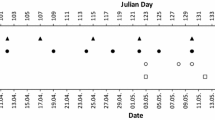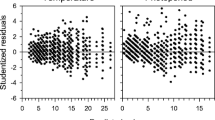Abstract
Key message
Bud break in European beech is generally known to be under strong photoperiodic control, but our data indicate that bud break in the northernmost populations is temperature limited.
Abstract
European beech (Fagus sylvatica) is among the dominant tree species in Europe, and is expected to increase its distribution northwards due to climate change. Although spring bud break in European beech is known to be under strong photoperiodic control, studies of populations from high elevations suggest a greater role of temperature in colder environments. This indicates that warming could yield advanced bud break for populations at high elevation and at high latitudes. Using live material collected in winter, spring and autumn from wild populations in Norway, representing the northernmost distribution range of European beech, we tested frost tolerance and effects of temperature and day length on bud break in controlled conditions. Furthermore, we observed bud break during spring in field conditions. Bud break in controlled conditions was faster with later sampling dates and higher temperatures, but showed little or no activity under short photoperiod. Field observations revealed earlier bud break in warmer sites, and remarkably, that bud break dates have advanced by more than 10 days in less than three decades. Frost tolerance tests showed a gradual decrease in bud intactness from January to March, and a gradual increase from October to December. Our data indicate that bud break dates in the northernmost European beech populations are limited by temperature, similar to observations of populations at high elevation in Central Europe. Further warming can thus be expected to yield earlier bud break at the species’ northernmost distribution range, possibly increasing the susceptibility of shoot tips to late spring frost events.





Similar content being viewed by others

References
Bertin RI (2008) Plant phenology and distribution in relation to recent climate change. J Torrey Bot Soc 135:126–146
Björkman L, Bradshaw R (1996) The immigration of Fagus sylvatica and Picea abies into a natural forest stand in Southern Sweden during the last 2000 years. J Biogeogr 23::235–244
Bjune AE, Helvik I, Birks HJB (2012) The Fagus sylvatica forests in the Larvik region, south-eastern Norway: their origin and history. Veget History Archaeobot 22:215–229
Bolte A, Czajkowski T, Kompa T (2007) The north-eastern distribution range of European beech—a review. Forestry 80:413–429
Bradshaw R, Lindbladh M (2005) Regional spread and stand-scale establishment of Fagus sylvatica and Picea abies in Scandinavia. Ecology 86:1679–1686
Caffarra A, Donnelly A (2011) The ecological significance of phenology in four different tree species: effects of light and temperature on bud burst. Int J Biometeorol 55:711–721
Caudullo G, Welk E, San-Miguel-Ayanz J (2017) Chorological maps for the main European woody species. Data Brief 12:662–666. https://doi.org/10.1016/j.dib.2017.05.007
Christensen RHB (2015) Ordinal—regression models for ordinal data. R package version 2015-01-21. http://www.cran.r-project.org/package=ordinal/. Accessed 15 Jan 2018
Cufar K, De Luis M, Saz MA, Crepinsek Z, Kajfez-Bogataj L (2012) Temporal shifts in leaf phenology of beech (Fagus sylvatica) depend on elevation. Trees 26:1091–1100
Falusi M, Calamassi R (1990) Bud dormancy in beech (Fagus sylvatica L.). Effect of chilling and photoperiod on dormancy release of beech seedlings. Tree Physiol 6:429–438
Frazer GW, Canham CD, Lertzman KP (1999) Gap light analyzer (GLA), version 2.0: imaging software to extract canopy structure and gap light transmission indices from true-colour fisheye photographs, users manual and program documentation. Simon Fraser University, Burnaby, British Columbia/Institute of Ecosystem Studies, Millbrook, New York
Fu YH, Campioli M, Deckmyn G, Janssens IA (2012) The impact of winter and spring temperatures on temperate tree budburst dates: results from an experimental climate manipulation. PLOS One 7:e47324
Fuchigami LH, Weiser CJ, Evert DR (1971) Induction of cold acclimation in Cornus stolonifera Michx. Plant Physiol 47:98–103
Greer DH, Warrington IJ (1982) Effect of photoperiod, night temperature, and frost incidence on development of frost hardiness in Pinus radiata. Aust J Plant Physiol 9:333–342
Gusta LV, Wiesniewski M (2012) Understanding plant cold hardiness: an opinion. Physiol Plant 147:4–14
Gusta LV, Wiesniewski M, Nesbitt NT, Tanino K (2003) Factors to consider in artificial freeze tests. Acta Hort 618:493–507
Hänninen H, Tanino K (2011) Tree seasonality in a warming climate. Trends Plant Sci 16(8):412–416
Heide OM (1993) Dormancy release in beech buds (Fagus sylvatica) requires both chilling and long days. Physiol Plant 89:187–191
Hofmann M, Durka W, Liesebach M, Bruelheide H (2015) Intraspecific variability in frost hardiness of Fagus sylvatica L. Eur J For Res 134:433–441
Hultén E (1971) The circumpolar plants. 2, Dicotyledons. Kungl. Svenska vetenskapsakademiens handlingar, 4:13:1. Almqvist Wiksell, Stockholm, p 463
Inatomi Y, Uno H, Iijima H (2017) Effects of sika deer (Cervus nippon) and dwarf bamboo (Sasa senanensis on Trillium populations in Akan National Park, eastern Hokkaido, Japan. Plant Species Biol 32:423–431
Ito H, Osawa N (2017) The effects of aggregation on survival and growth rate in the wood-feeding cockroach Panesthia angustipennis spadica (Blaberidae). Entomol Sci 20:402–408
Junttila O, Kaurin Å (1990) Environmental control of cold acclimation in Salix pentandra. Scand J For Res 5:195–204
Körner C, Basler D (2010) Phenology under global warming. Science 327:1461–1462
Kramer K, Degen B, Buschbom J, Hickler T, Thuiller W, Sykes MT, de Winter W (2010) Modelling exploration of the future of European beech (Fagus sylvatica L.) under climate change—range, abundance, genetic diversity and adaptive response. For Ecol Manage 259:2213–2222
Kreyling J, Buhk C, Backhaus S, Hallinger M, Huber G, Huber L, Jentsch A, Konnert M, Thiel D, Wilmking M, Beierkuhnlein C (2014) Local adaptations to frost in marginal and central populations of the dominant forest tree Fagus sylvatica L. as affected by temperature and extreme drought in common garden experiments. Ecol Evolut 4:594–605
Lenz A, Hoch G, Vitasse Y, Korner C (2013) European deciduous trees exhibit similar safety margins against damage by spring freeze events along elevational gradients. New Phytol 200:1166–1175
Lenz A, Hoch G, Vitasse Y (2016) Fast acclimation of freezing resistance suggests no influence of winter minimum temperature on the range limit of European beech. Tree Physiol 36:490–501
Luiz OJ, Woods RM, Madin EMP, Madin J (2016) Predicting IUCN extinction risk categories for the world’s data deficient groupers (Teleostei: Epinephelidae). Conserv Lett. https://doi.org/10.1111/conl.12230
Menzel A, Sparks T, Estrella N, Koch E, Aasa A, Ahas R, Alm-Kübler K, Bissolli P, Braslavská O, Briede A, Chmielewski FM, Crepinsek Z, Curnel Y, Dahl Å, Defila C, Donnelly A, Filella Y, Jatczak K, Måge F, Mestre A, Nordli Ø, Peñuelas J, Pirinen P, Remisová V, Sheifinger H, Stritz M, Susnik A, van Vliet AJH, Wielgolaski FE, Zach S, Zust A (2006) European phenological response to climate change matches the warming pattern. Glob Change Biol 12:1969–1976
Mølmann JA, Asante DK, Jensen JB, Krane MN, Ernstsen A, Junttila O, Olsen JE (2005) Low night temperature and inhibition of GA biosynthesis overrides phytochrome action and induce bud set and cold acclimation, but not dormancy in PHYA overexpressors and wild-type of hybrid aspen. Plant Cell Environ 28:1579–1588
Murray MB, Cannel MGR, Smith RI (1989) Date of bud burst of 15 tree species in Britain following climatic warming. J Appl Ecol 26:693–700
Myking T, Yakolev I, Ersland GA (2011) Nuclear genetic markers indicate Danish origin of the Norwegian beech (Fagus sylvatica L.) populations established in 500–1000 AD. Tree Genet Genomes 7:587–596
Nihlgård B (1969) The microclimate in a beech and a spruce forest-a comparative study from Kongalund, Scania, Sweden. Botaniska Notiser 122:333–352
Nordli Ø, Wielgolaski FE, Bakken AK, Hjeltnes SH, Måge F, Sivle A, Skre O (2008) Regional trends for bud burst and flowering of woody plants in Norway as related to climate change. Int J Biometeorol 52:625–639. https://doi.org/10.1007/s00484-008-0156-5
Olsen JE, Junttila O, Nilsen J, Eriksson ME, Martinussen I, Olsson O, Sandberg G, Moritz T (1997) Ectopic expression of oat phytochrome A in hybrid aspen changes critical day length for growth and prevents cold acclimatization. Plant J 12:1339–1350
Pignatti S (1982) Flora d’Italia. Edagricole, Bologna
Pinheiro J, Bates D, DebRoy S, Sarkar D, R Core Team (2015) nlme: linear and nonlinear mixed effects models. R Package Version 3:1–122
R Core Team (2014) R: a language and environment for statistical computing. R Foundation for Statistical Computing, Vienna
Saltré F, Duputié A, Gaucherel C, Chuine I (2014) How climate change, migration ability and habitat fragmentation affect the projected future distribution of European beech. Glob Change Biol 21:897–910
Strømme CB, Julkunen-Tiitto R, Krishna U, Lavola A, Olsen JE, Nybakken L (2015) UV-B and temperature enhancement affect spring and autumn phenology in Populus tremula. Plant. Cell Environ 38:867–877
Taschler D (2004) Summer frost resistance and freezing patterns measured in situ in leaves of major alpine plant growth forms in relation to their upper distribution boundary. Plant Cell Environ 27:737–746
Visnjic VC, Dohrenbusch A (2004) Frost resistance and phenology of European beech provenances (Fagus sylvatica L.). Allgemeine Forst Jagdzeitung 175:101–108
Vitasse Y, Basler D (2013) What role for photoperiod in the bud burst phenology of European beech? Eur J For Res 132:1–8
Vitasse Y, Delzon S, Bresson CC, Michalet R, Kremer A (2009) Altitudinal differentiation in growth and phenology among populations of temperatre-zone tree species growing in a common garden. Can J For Res 39:1259–1269
Waalen WM, Tanino KK, Olsen JE, Eltun R, Rognli OA, Gusta LV (2011) Freezing tolerance of winter canola cultivars is best revealed by a prolonged freeze test. Crop Sci 51:1988–1996
Wareing PF (1953) Growth studies in woody species. V. Photoperiodism in dormant buds of Fagus sylvatica. Physiol Plant 6:692–706
Weiser CJ (1970) Cold resistance and injury in woody plants. Science 169:1269–1278
Welling A, Kaikuranta P, Rinne P (1997) Photoperiodic induction of dormancy and freezing tolerance in Betula pubescens. Involvement of ABA and dehydrins. Physiol Plant 100:119–125
Welling A, Moritz T, Palva ET, Junttila O (2002) Independent activation of cold acclimation by low temperature and short photoperiod in hybrid aspen. Plant Physiol 129:1633–1641
Zuur AF, Ieno EN, Walker NJ, Saveliev AA, Smith GM (2009) Mixed effects models and extensions in ecology with R. Springer Verlag, Berlin, pp 101–142
Acknowledgements
This study was funded by the Research Council of Norway (Grant no. 225018). We wish to thank Ellen Finne at the County Governor of Vestfold for providing help in localising beech stands. We also wish to thank the County Governor of Hordaland and the County Governor of Vestfold for granting permission to collect samples from the nature reserves in Seim (Hordaland) and Holmestrand (Vestfold).
Author information
Authors and Affiliations
Corresponding author
Additional information
Communicated by Wieser.
Rights and permissions
About this article
Cite this article
Strømme, C.B., Schmidt, E., Olsen, J.E. et al. Climatic effects on bud break and frost tolerance in the northernmost populations of Beech (Fagus sylvatica) in Europe. Trees 33, 79–89 (2019). https://doi.org/10.1007/s00468-018-1760-6
Received:
Accepted:
Published:
Issue Date:
DOI: https://doi.org/10.1007/s00468-018-1760-6



